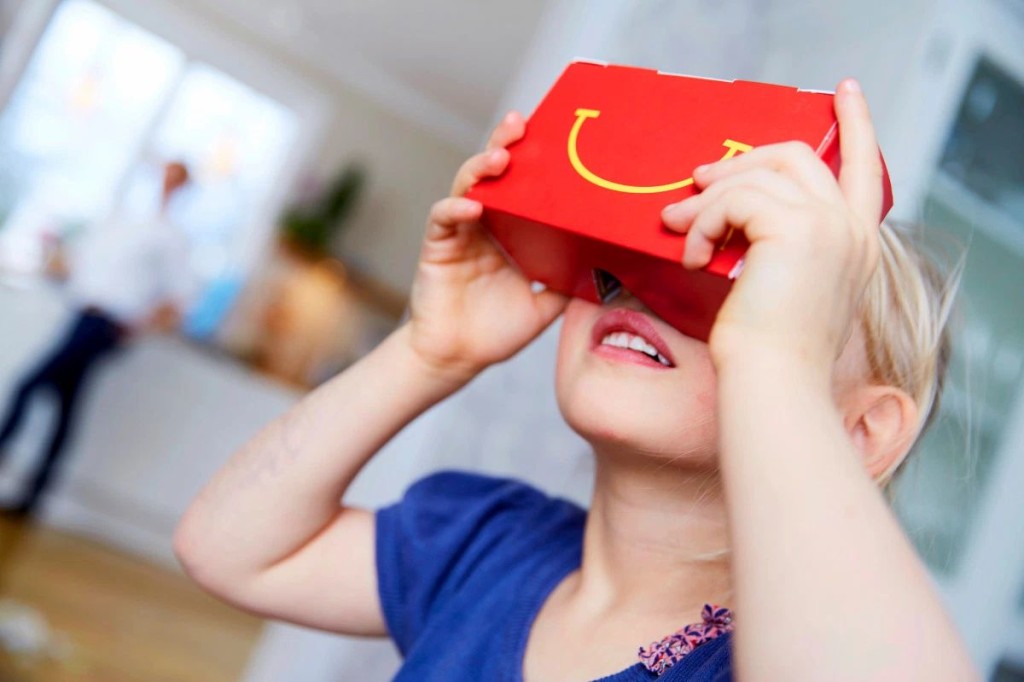While millions of consumers await the arrival of affordable high-end VR equipment, there’s one group that’s not waiting to take advantage of the technology: marketers. The use of VR in marketing has been going on for years now, as they seek to capitalize on consumer excitement for the technology. We’ve seen movie studios using VR to promote films, and Marriott using VR to promote its hotel experience, and now we’re seeing McDonald’s use VR as a Happy Meal promotion.
The concept is simple: use a Happy Meal box as a VR viewer, in the manner of Google Cardboard. A few perforations let you convert it into Happy Goggles, where you slide in your smartphone and play a game McDonald’s had created for the promotion. Plus you get a Happy Meal along with it. What kid wouldn’t like this?
Don’t rush out to your local McDonald’s just yet, though. This promotion is courtesy of McDonald’s Sweden, and right now they’re just giving it a trial run at 14 restaurants over two weekends. The game included with the promotion is a ski-themed app called Slope Stars, which of course you can still play without the Happy Goggles. Equally, you can use the Happy Goggles with other mobile VR titles, at least until the cardboard wears out and you need to buy a new Happy Meal.
Adweek spoke to Jeff Hackett, the marketing director of McDonald’s Sweden about the promotion. He believes it’s “a really exciting opportunity to connect families in digital times,” and continued, “Parents can learn more about their children’s knowledge and experience of the digital world. And purposeful gaming can also be a great joint activity that helps families interact on equal terms.” Right now it’s a very small test, but Hackett also said “this is the first trial run globally” for the Happy Goggles. It seem likely this promotion may well be rolled out elsewhere if it does well.
Marketing VR is already becoming a regular thing when you want to attract people and engage them with a certain flair. For marketers, VR offers a number of positive factors; it’s the very latest in technology, and it’s something that most people are (a) curious about and (b) interesting in experiencing for themselves. The actual experience of VR itself offers the benefits of being immersive (so you’re focused entirely on the message), it’s impactful (creating a more intense and there more memorable experience), and it’s novel, meaning you’re more likely to get social media uptake and even media coverage of your marketing efforts.
VR is finding a home in marketing across a wide variety of industries. Marriott has been getting rave reviews for its varied VR efforts, like this virtual honeymoon.
Merrell has used VR to support the launch of a new hiking boot, the Capra, by giving the user the experience of a dangerous mountain hike. Patrón took its signature tequila brand into VR with an adroit mix of live action and computer graphics to follow the entire production process. And it should be no surprise that a car company is using VR, where Volvo has done expertly in the launch of their XC90 SUV. Fashion, movies, food, soft drinks, and travel… the list of companies using VR in marketing efforts goes on.
The uses of VR in marketing go well beyond the value of the technology as a way of attracting attention. Companies are now exploring the direct revenue potential of VR in creating virtual showrooms for products, where you can immerse yourself in a product experience that’s an order of magnitude more compelling than looking at some pictures or reading some text. Yes, it’s a big ask to get someone to put on a VR headset, but that’s getting easier to do all the time.
Marketing seems like a natural fit for many of VR’s qualities, and the attraction is bound to get more powerful. While high-end VR systems are going to be fairly limited in numbers for a while, mobile VR is already widespread with Google Cardboard and efforts like McDonald’s are going to see that spread to millions more people very quickly. The next major effort to hit the market will be the mid-priced headsets, ranging from Mattel’s View-Master (a steal at only $29.99) to Samsung’s Gear VR at $99, and the rumored mid-range new Google device that might be a couple of hundred dollars (but would not require a smartphone, if the rumor is correct).
As VR catches on in popularity, the low cost and easy availability of reasonably priced VR gear will mean that marketing efforts can find a wide audience. As of right now, most VR marketing has been based around creating a special event at a location, because it relies on high-end hardware that’s difficult to transport. The creative thinking changes when you have millions of people with the capability to experience VR already in their possession; you start thinking about sponsoring experiences, creating special VR content for your brand, or perhaps even making VR commercials that get added to other VR experiences. Ad-sponsored VR? Why not? The business model for VR apps is completely open, and none of the parameters have been set.
This is a key time for marketers to think about putting VR into their strategic plans for the future. The technology is cutting-edge right now, it’s new and hot and attractive. The possibilities of what you can do both creatively and business-wise are just beginning to be explored. Bold marketers can seize the moment and get in on the ground floor of the VR revolution, helping to shape how VR impacts marketing and indeed the very business of VR apps. The time is not so distant when people will be asking what your VR strategy is as a standard question, and one of those people is likely to be your boss. It’s time to start coming up with some good answers to the VR marketing question.

